PHENOTYPINGOF RICE GENOTYPES AGAINST ASIAN RICE GALL MIDGE, Orseolia oryzae (WOOD-MASON) BIOTYPE IV INANDHRAPRADESH..
0 Views
HARATHI, P.N1., RAJA SEKHAR2, P., HARI PRASAD, K.V1., BHASKAR REDDY, B.V2 AND RAVINDRA REDDY, B1
S.V. Agricultural College, Tirupati,1 RegionalAgricultural Research Station2, Tirupati
ABSTRACT
To develop rice cultivars resistant to Asian rice gall midge, Orseolia oryzae (Wood-Mason) biotype IV, phenotyping of rice cultivars was conducted during 2016-17 under field conditions at ARS, Ragolu. A total of 105 lines were screened against Asian rice gall midge. Gallmidge incidence as per cent plant damage and per cent silver shoot damage was recorded at 30 and 50 days after transplanting. None of the entries were found highly resistant to Asian gallmidge at Ragolu. However, the entry RGL 7010 was recorded with per cent plant damage of less than 5 per cent, while most of the entries recorded 100 per cent plant damage. These entries could be used as donor in breeding experiments to develop gall midge tolerant varieties.
KEY WORDS:
Phenotyping, Rice gall midge, rice genotypes, Cecidomyiidae, Orseolia oryzae, Oryza sativa.
INTRODUCTION:
Rice is India’s predominant crop, and is the staple
food of majority of population. India has the world’s largest area under rice cultivation and is one of the largest producers of white rice, accounting for 20 per cent of global rice production. In India, rice is cultivated in an area of 42.7 million hectare (mha) with a total production of 161.27 m tonnes (mt) (IRRISTAT, 2017).
Rice crop is attacked by number of insect pests, of which Asian rice gall midge, Orseolia oryzae (Wood-Mason) is one of the important pest which causes extensive@ damage. Identification of new sources of resistance to major insect pests is the prime objective of host plant resistance, which includes evaluating the performance of breeding lines, identifying stable source of resistance and transfer them to elite lines. The discovery and use of gall midge resistance genes should be made as efficient as possible because there are some biotypes for which effective resistance genes have not yet been found or for which resistance relies precariously on a single major gene (Bennett et al., 2004).
MATERIALS AND METHODS
A total of 105 cultivars (88 from ARS, Nellore and 17 from ARS, Ragolu) were studied under field conditions at Agricultural Research Station, Ragolu during kharif, 2016-17 with Kavya as resistant check and TN 1 as susceptible check. Each entry was transplanted in a single row of 20 hills per cultivar with a spacing of 20 x 15 cm and was replicated twice. Seedlings of 30 days old were transplanted with a single seedling per hill. Normal agronomic practices were followed during the season.
For scoring the damage due to rice gallmidge, total number of hills, no. of infested hills, total no. of tillers and total number of tillers with silver shoot were recorded at 30 DAT (Days after Transplanting ), 50 DAT and the percent plant damage and per cent silver shoot infestation was calculated as follows:
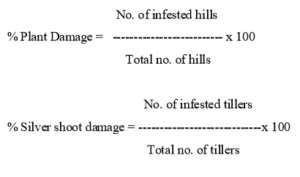
Per cent damaged plants and per cent silver shoot damage per entry were calculated and analysis was done by using ANOVA in SPSS 20.0 software. To check the level of resistance/susceptibility the percent silver shoot in each entry was converted to 0-9 scale by following the IRRI Standard Evaluation System (SES) for rice (IRRI 2002).
Standard Evaluation Systems for evaluating rice for resistance to Rice Gall Midg (IRRI 2002)
RESULT AND DISCUSSION
During 2016-17, the incidence of gall midge was moderate to very high with 100 per cent plant damage. At 30 DAT, per cent silver shoot damage was between 0.00 per cent (RGL 7002, RGL 7003 and RGL 7009) to 16.8 per cent (5757-85-1-1-3). Lowest per cent plant damage was recorded in RGL 7002, RGL 7003 and RGL 7009 (0.00%) and highest in the genotype NLR 5787-24-4-1-1 (95.83%).
At 50 DAT, highest per cent plant damage of 100 was observed in 39 entries and genotypes with < 10 per cent were RGL 11414, RGL 7002, RGL 7003, RGL 7005, RGL 7006, RGL 7009, RGL 7010 and NLR 4003. The entries NLR 4003, RGL 7005 and RGL 7006 were not selected for genotyping because the damage in these entries was above 10.00 per cent (NLR 4003 (16.67%), RGL 7005 (20.83%) and RGL 7006 (16.67%) at 30 DAT (Table 1).
Overall grouping of the entries phenotyped against rice gall midge based on the reaction pattern observed at 50 DAT was presented in Table 2. The per cent silver shoot damage at 50 DAT ranged from 0.29 (NLR 4003)
with per cent plant damage of < 5.0 was recorded in the entry, RGL 7010 i.e., 3.00 per cent and with per cent sil-ver shoot damage of 1.78. The per cent silver shoot dam-age and per cent plant damage at 50 DAT in the suscep-tible check, TN 1 was 23.01 per cent and 96.67 per cent, respectively. The frequency of test entries under differ-ent levels of gall midge damage, as a reflection of pest pressure and performance of entries, at ARS, Ragolu was given in fig. 1.
None of the entries were found to be highly resistant at ARS, Ragolu. Similar results were presented by Rabindra Prasad (2011) who reported the susceptibility of 28 hybrids to biotype III at Jharkand. Even the Resistant rice variety Lalat had 11.41 per cent plant damage. Anusha et al. (2017) reported that, of the 38 pre-breeding lines tested, 12 entries were found resistant to biotype I at IIRR, Hyderabad, 6 lines were resistant to biotype III at Jagtial and none of the entries were resistant to biotype IV M at Warangal.
The entry selected, RGL 7010 could be exploited in resistant breeding programme for the development of genotypes resistant against rice gall midge after the identification of gene conferring resistance through molecular studies.
LITERATURE CITED:
- Anusha, Ch. 2017. Identification of Novel sources of resistance and their mechanisms to rice gall midge, Orseolia oryzae (Wood-Mason). Ph.D. Thesis. Professor Jayashankar Telangana State Agricultural University, Hyderabad.
- Bennett, J., Katiyar, S.K., Verulkar, S.B., Chandel, G, Zhang, Y., Huang. B. 2004. Pyramiding of gall midge resistance genes in rice: different approaches and their implications. New Approaches to Gall Midge Resistance in Rice. International Rice Research Institute. 139-152.
- IRRISTAT, 2017:http://ricestat.irri.org:8080/wrsv3/ entrypoint.htm.
- IRRI, 2002. Standard Evaluation System for Rice.
- International Rice Research Institute, Manila. 21.
- Rabindra Prasad, 2011. Status of the Rice Gall Midge (Orseolia oryzae W.M.) in the State of
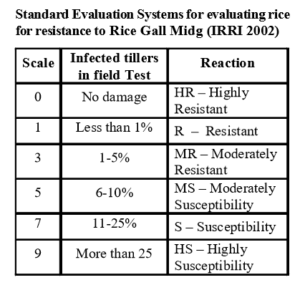
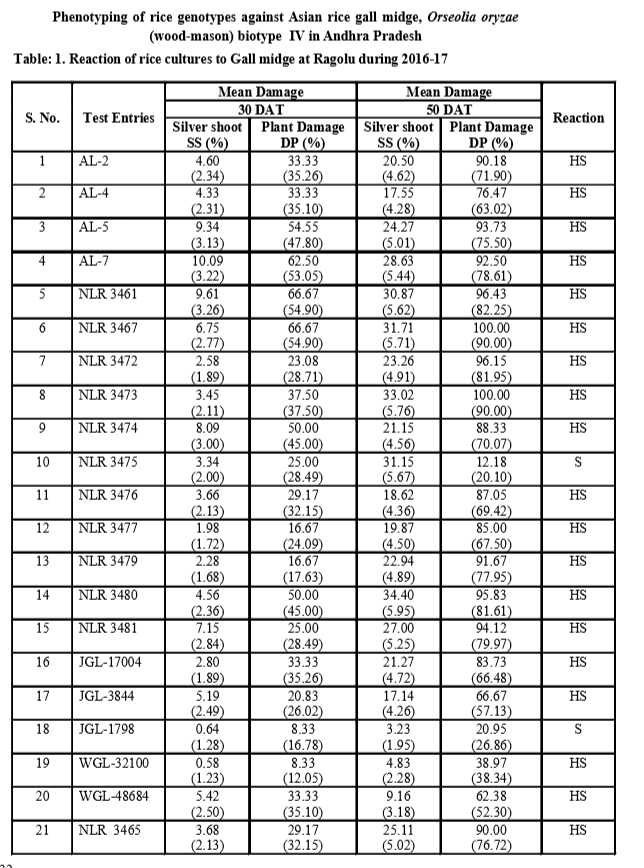
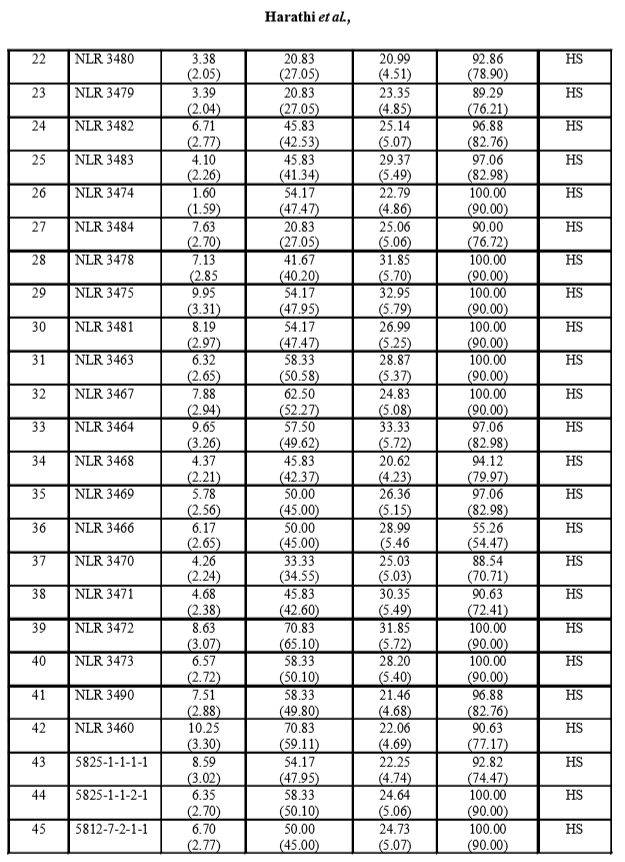
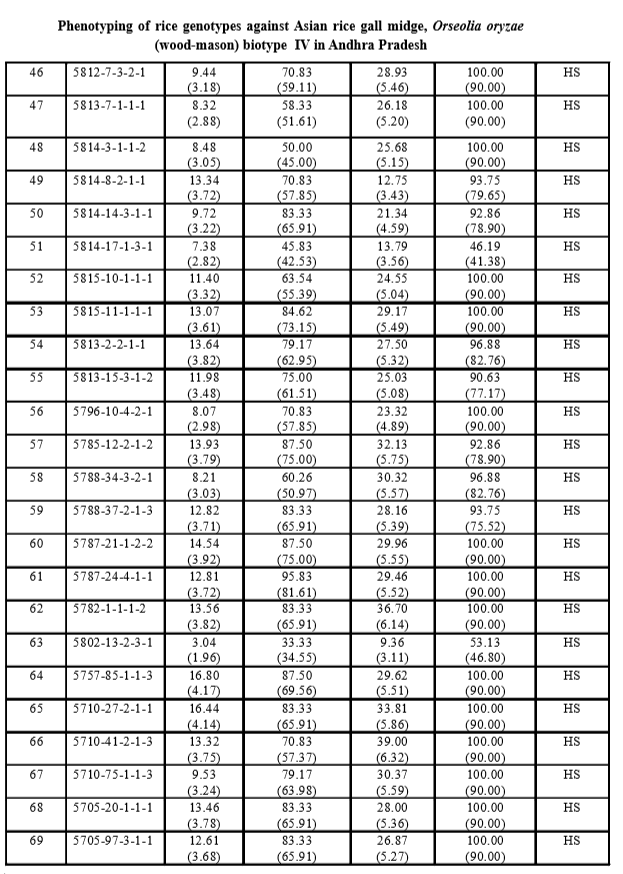
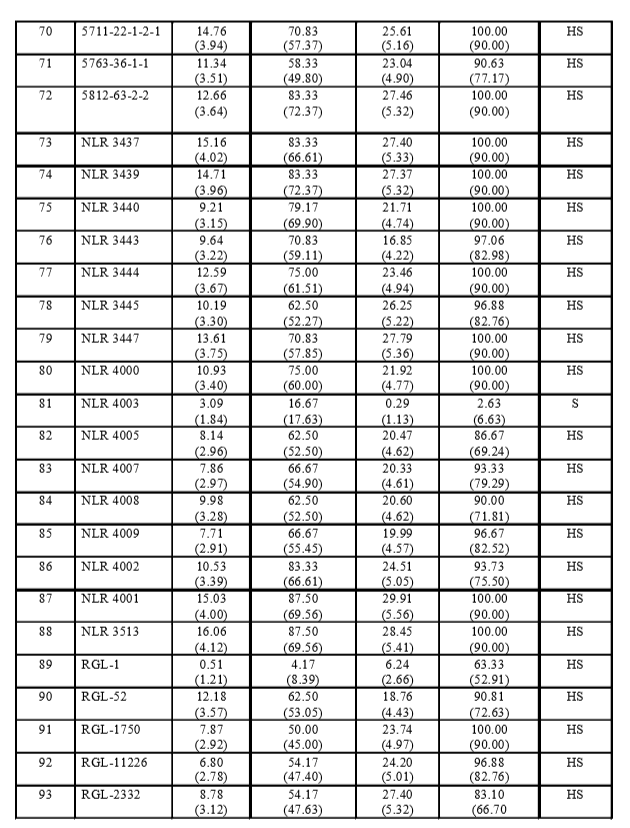
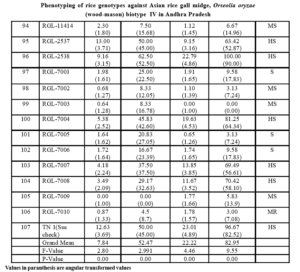
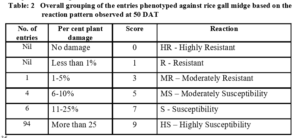
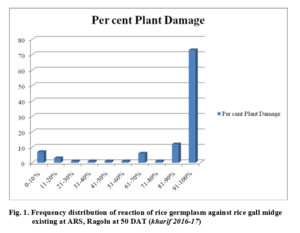
- Bio-Formulations for Plant Growth-Promoting Streptomyces SP.
- Brand Preference of Farmers for Maize Seed
- Issues That Consumer Experience Towards Online Food Delivery (Ofd) Services in Tirupati City
- Influence of High Density Planting on Yield Parameters of Super Early and Mid Early Varieties of Redgram (Cajanus Cajan (L.) Millsp.)
- Influence of Iron, Zinc and Supplemental N P K on Yield and Yield Attributes of Dry Direct Sown Rice
- Effect of Soil and Foliar Application of Nutrients on the Performance of Bold Seeded Groundnut (Arachis Hypogaea L.)

